It’s Day Three of the new bike signal at Broadway and Williams in North Portland. When PBOT turned on the signal Wednesday, some safety issues became apparent, so they immediately came up with a list of fixes that we shared with you yesterday.
Thankfully, as of this morning, (pretty much) all those fixes are in place and I’m happy to report that the signal is operating during peak hours without any human assistance (a flagger and a police officer were present during peak times yesterday)! During several minutes of observation this morning, everything seemed to be going well. There were no near misses (well, not quite, see below), no honking horns and no middle fingers.
The first thing I noticed this morning was how PBOT has made the far-side bike signal (on the northwest corner of the intersection) stand out better alongside the other lane signals. There is a much larger display (8-inch lenses were replaced with 12-inch ones) and the frame behind the lenses is now yellow. Right above the signal is a “Bike Signal” sign with a bike symbol on it. There is also a new “No Turn on Red” LED sign. It is not like the one on NE Oregon and Interstate that flashes. This sign simply goes on when the bike signal is green and then shuts off.
On the approach as you roll westbound toward Williams in the bike lane, PBOT has put in two temporary signs — “Signal Ahead” and “Bikes Use Bike Signal” — and there is a spray-painted “Stop Here” in the bike lane right at the Williams intersection.
From my observations this morning, more needs to be done to prevent the two right-turn lanes from violating their advanced stop bar. Many of the motor vehicles I saw this morning, did not comply with that line. It’s somewhat understandable because it isn’t colored like the bike boxes and there’s a crosswalk line just a few feet in front of it. I think PBOT should consider a “Wait Here” marking to remedy this problem.
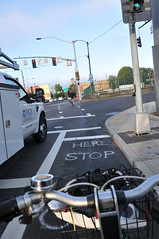
working as intended. This truck
is supposed to stop at the white
line near my bell in the bottom
left of this photo.
Another issue that I observed this morning, was something I was concerned about in my initial report on Wednesday. When a long wheelbase vehicle (like a semi-truck pulling a long trailer) turns right from the right-most turn lane, the rear of their trailer rolls dangerously close to the bike lane. This morning, a woman was stopped at red in the bike lane and a long truck rolled just a few feet from her as she watched in a sort of surreal moment — at one point looking around as if she wasn’t sure she was in the right place. Check out the series of photos below for what I mean:
Yes, this person did not get run over and yes, the long truck did not encroach fully into the bike lane; but is this the type of experience we want to subject people to when they use our roads? Do you think this is the type of thing that will encourage older people and people with small children to use this route? I don’t. One solution might be to move the bike lane stop bar back a few feet.
A few final notes…
I timed the bike signal phase at about 13-14 seconds. The timing works great in coordination with westbound traffic from Victoria Street. Many people using the bike lane were able to get the green and ride right through Williams without stopping. On that note, crews were out this morning to install a new video camera detection system that will improve the signal timing even more (currently, the signal is set to go on automatically each cycle).
If you are sufficiently wonky, check out the video I made of a complete signal cycle…
Now that these changes have been made, I’d love to hear what people think about it. How’s it working for you?


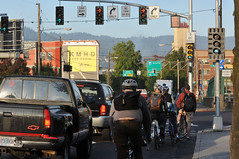
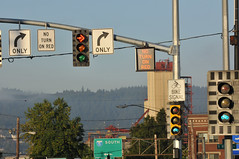
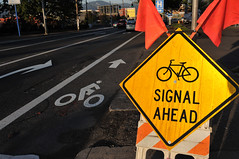
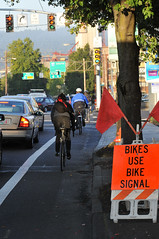
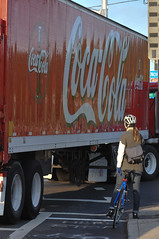

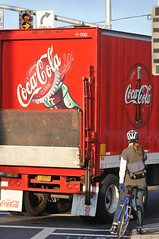
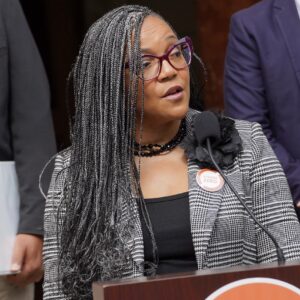
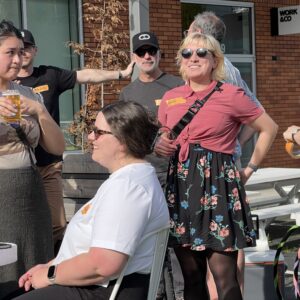

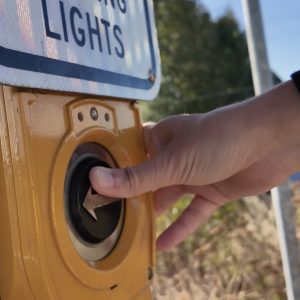
Thanks for reading.
BikePortland has served this community with independent community journalism since 2005. We rely on subscriptions from readers like you to survive. Your financial support is vital in keeping this valuable resource alive and well.
Please subscribe today to strengthen and expand our work.
I really hate to be a naysayer, so I’ll start by saying the light worked just fine for me this morning. No issues. Yesterday, an older, more tentative cyclist seemed to enjoy the slow, safe passage the light provided. I, on the other hand, miss the way it was because I never had any problem crossing the lanes (making the transition) to the bike lanes that go west before the bridge.
All that said, I was nearly right-hooked beyond the new light, at the usual spots on Broadway. Totally oblivious drivers. Coming home yesterday, as is so often the case, at Lloyd and Oregon, as soon as the No Turn on Red light started flashing (flashing!), a driver turned right anyway, right in front of several bikers; the same will no doubt happen at the new Broadway light. I myself heard plenty of horns this morning.
All around, I think the effort is OK. Just OK. I wonder what “fixes” like this will lead to: better exchanges between drivers and bikers, or resentment against bikers for what for many drivers will seem like an inconvenience–never mind that it *should* prevent drivers from accidentally right-hooking bikers. A few blocks from the light, though, no measures have been taken to prevent right hooks–is the inconsistency better than what was there before?
It’s a good first step. What took so long? Answer: The BTA is too cozy with PBUT.
I hope the fixes Jonathan mentioned can be done in 2 weeks. Lots of paint to keep cars from pulling right up to the crosswalk on a red light. Bikes should also stop 6 feet back from the crosswalk.
Next up, call 823-SAFE and press 4. report the several hundred yards of road with no bike or ped crossing. Naito parkway and the steel bridge. It’s another highly used death spot where the BTA and PBUT have made no action.
I think the fear that this will lead to resentment against people on bikes is overblown. I suspect the same fears were expressed with the bike signal at the west end of the Broadway Bridge, the scramble signal at Lloyd & Oregon, the hawk on Burnside, and etc. et al. And from my experience all road users really appreciate the added safety and predictability that those pieces of infrastructure provide. Sure there are some kinks to work out, but given a little time, I’m sure this new signal and lane configuration will be seen in the same light.
Jonathan: The biker in your photo series also didn’t comply with the advanced stop bar. I believe you said in a previous article that PBOT moved the stop bar back behind the crosswalk a bit in order to avoid the problem you showed above. If her front wheel were behind the stop bar that would have been much less of a close call.
cyclist,
i hear you and thank you for bringing this up. But just for the record, it looks to me like the women’s tire is behind the bike lane stop bar.
As for trucks and long vehicles, is it possible for PBOT to create a restriction that these vehicles can only use the leftmost right-turn lane? This would assume both lanes allow the same road access after the right turn – I don’t recall if there is some road access other than I-5 that is only accessable via the rightmost right-turn lane.
This might be the simplest way to keep long vehicles from encroaching upon those on bicycles waiting for their green. It would probably also make it easier for those long vehicles needing more room to swing wide to make the turn to do so. I am guessing the current situation is made worse here because long vehicles with right-turning vehicles to their left cannot swing wide to make the right turn.
the led not turn light is awesome. kudos to the pbot. i really did not expect them to be this engaged in getting this right.
How about a red light camera for illegal right turners?
Jonathan: I think you’re right, it must be an issue of perspective because the first time I looked closely at it, it looked like the front wheel was well forward of the stop bar.
It would have been nice to get that picture from a different angle so you could see how much room there really was between the truck and the cyclist.
Engineers will never design through/right-turn lanes to the right of other through/right-turn lanes, because this design is known to cause conflicts and car crashes.
Yet through/right-turn bike lanes are placed to the right of other through/right-turn lanes causing car-bike conflicts & crashes!
Why do engineers do this?
Riding far to the right creates a virtual through/right-turn lane to the right of a through/right-turn lane causing conflicts & crashes!
Why do laws encourage this?
Dominic. You are 100% correct. Why?
My answer to “why?” is because cyclists are not encouraged to raise a fuss by the docile bike leadership. We let allow safety come last through lack of action.
I’d like to hear other people answer why too.
“I’d like to hear other people answer why too.”
My answer is, “because of irrationality”. As cyclists, we suffer under the Tyranny of The Majority. Those who are supposed to represent us are unwilling or unable to effect the kinds of legal changes that would make bicycle travel safer and more within reach of the average person. The reason those representatives don’t or can’t effect those changes is because the majority (non-cyclists) have wrong-headed, irrational notions about bike travel. Among those irrational notions are these:
1. Bikes are toys
2. Cyclists = Pedestrians
3. “Bikes” cause more of a delay to motorists on the road than the plethora of other delays encountered every day (which motorists willingly accept)
4. Only drivers pay for roads and should therefore have exclusive use of them.
5. Cycling is inherently dangerous, and cyclists deserve whatever happens to them on the road (especially if they don’t wear a helmet)
6. Driving is a right
7. Driving fast is a right
From this perspective, the optimal solution is to ban bikes from the street. Barring that, if bikes are allowed on the street, the top priority should be not to make them safer, but to keep them out of The Way. Hence the laws we have: far to the right, mandatory sidepath, no vehicular manslaughter statute. Under current laws, the life of a cyclist is valued at about $250, the same amount as the fine for rolling a stop sign.
Sorry if this is a really old question but I only just realized that both motor vehicle lanes are right turn only. It used to be PBOT’s excuse was that the bike lane was placed between the two lanes and couldn’t go all the way left of them (to avoid right hooks) because the left-most turn lane could also go straight.
So why not now transition the turning cars to the right of cyclists (like on Vancouver at the Fremont Bridge approach)? Is this because of the space issues mentioned a few months ago?
#6 3-speeder
+1
When I was sent to a Commercial truck driving school by the military one of the biggest safety points they stressed was thinking ahead. This means being in the correct lane ahead of time.
I don’t know if it is a law but it was hammered repeatedly that if you are going in to a set of turn lanes going the same direction you need to be on the outside lane: it allows you to make the wide turn geometry necessary in dense urban areas.
I rode through this for the first time this morning and thought it was great (thanks for the heads up to push the button.) However, other changes on Broadway are not so terrific. Moving the bike lane to the far right as you approach the the Broadway Bridge approach creates the nasty potential for a right hook from the many trucks/cars turning onto Interstate. Any plans for a green box there?
why is putting the bike specific signal on a trigger better than simply including it in the signal cycle?
This morning at 7 AM, I waited patiently ’til the bike light turned green. As I began to move, the second car in line honked, apparently to encourage the first car to turn right on red in defiance of the very clear “NO TURN ON RED” sign. I nearly got right-hooked at 3 mph. I’m with those who liked taking the lane better. I don’t like it when my safety is predicated on everyone following traffic laws. I would much rather work my way into the lane while assessing who is and who isn’t paying attention.
While I never had any close calls with the old traffic rules at this location I do appreciate the efforts taken to rectify one of the trickier spots on my route.
That said, today I had both of the situations you mentioned occur. While waiting (behind the wait bar) for the green bike signal a semi rolled nearly a full wheel through the bike lane as I hustled toward the curb to avoid a collision. When I finally got the green cars proceeded to turn right against the signal, though they did at least yield to me. I’m prepared for the signal transition to take some time. Until then that intersection will remain one where I’ll be especially cautious.
The changes look good.
But it isnt good enough, there are still two huge problems:
Right hooks will happen. Especially as another poster mentioned, car 2 or 3 in line will honk to pressure number 1 to make an illegal turn.
Second, look at the video. Count how long the cyclists wait, they have the longest wait in the entire intersection. By having the bike lane to the left of the turn lanes, EVERYONE gets more green time instead of splitting a green between the bikes and the right turns.
I dont understand how the car-centric LOS measure didnt encourage having the bike lane on the left because restricting the right turns causes backups.
It seems like the design wont change because so much money was wasted on the bike signal. The only cheap way to make things better is to paint the bike lane and install soft hit posts to encourage trucks to make a wider turn. Or as someone else said, a sign instructing large vehicles to use the outer turn lane.
Let’s be frank: the real priority here is the highway, and everything comes after that.
It would be great to see a red light camera here. No right-turn compliance was an issue before the new improvements.
I watched the video and agree that the bike stop line definately needs to be moved back. The first cyclists were smart enough to stop on the right hand side, the person in the blue coat stopped on the left side of the bike lane in the same are you can see cars and trucks come very close to that spot if not into it when they make their turn. It’s a good time to make these sugestions while they are still listening to input.
Went through it for the first time last night heading downtown. I think the changes are good for the most part. #8 suggestion of a red light camera would not be a bad idea.
I’m still not going to brave it, personally. I rode NE Broadway a total of once and found it completely terrifying. I’m glad they’re starting to improve it, though!
I was driving straight on Bway and was scared for the bikers, both lanes of cars were turning on RED. not sure how I’ll handle it when I’m on my bike, feeling like I’ll need an air horn to compete. Would love to see a camera for tickets and patrols for a while.
Thanks for the thorough reportage. It could seem like droll minutiae to an outside observer but this kind of stuff has real life-and-death consequences. I’m glad a third party observer’s taking the time lay it out for us in a straight forward, analytical manner.
I think drivers may mistake the bike signal for their green light, it’s more visible than the No Turn on Red sightn. Also, it sucks that they made both of the right non-bike lanes right turn only. Now cars have to get in the far left lane in order to go straight, with no advance warning. I do appreciate the city’s efforts, but I think the old setup was probably safer. I’m curious to know what the traffic statistics are on reported right hooks and close calls there prior to the change.
Some perspective from the Water Bureau drivers and commuters – Coming up Victoria to Broadway, if a commuter wants to stay on Broadway, they have to be in the left lane on Victoria and transition to the left two lanes on Broadway. This is a significant change that has created confusion and near miss’ for motor vehicles at that intersection. As we stop in the left two lanes, some motor vehicles heading west on Broadway now try to leap-frog to the far right lane to access Vancouver, Flint, Wheeler, Benton or Ross after they clear the I-5 right lanes and the bike lane. The bike lane light activates to green with the west-bound motor vehicles. When the leap-frogging occurs, it puts the motorist in the north west-bound lane at risk, as well as the bicyclists. We have been sharing these issues with our drivers and employees, and will continue to do so. We also have some meetings set up to discuss this with PBOT. We will do whatever we can to help remedy the issues.
This isn’t a part of town I ever ride in, but after reading the coverage, and seeing the before (Google maps still has the pre-signal lane configuration) and after, I have to strenuously agree with Steve B in his comment (#20). This signal was not a way to make a dangerous intersection safer. It was a reaction to taking a reasonably safe intersection and making it very dangerous by prioritizing traffic entering the freeway, and attempting to keep bike traffic “out of the way”. I would be interested to know whether adding a second turn-only lane provides more throughput than allowing turns on red (as I imagine was legal and safe with the prior configuration). I would also be interested to know when the installation of a bike signal became part of the plan, because it seems like an afterthought here.
re biciclero comment 28, a lot of us would be interested, because so far as anyone here knows, the “plan” was not vetted through any public process.
If traffic engineers want to say “Stop Here”, why do they write “Here Stop”? Do they really think that riders and drivers look straight down at the first word, and then are surprised to see the second word scroll up before them? The phrase is visible in it’s entirety when you first see it. Reminds me of the painted warning on a walkway at Oakland Airport: “Step Your Watch”.
Second and more relevant comment: Very few drivers seem to know what a stop bar is, and pull up to the crosswalk line.
It’s a death trap. I went through there in a car, mistook the new bike signal for a green momentarily, and then watched someone swing through the outside lane of the corner on the red at 30mph. Seriously, someone could easily get killed there.